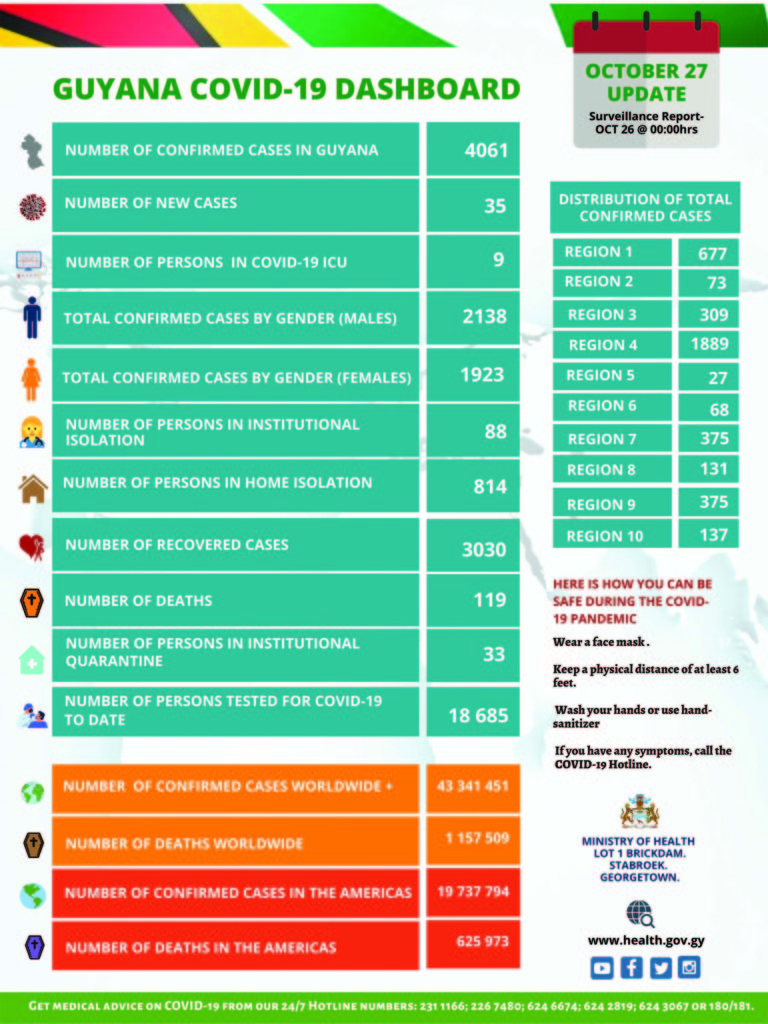Home News COVID-19 death toll reaches 121
…Health Ministry to ramp up testing to 1000 per day
 Two more deaths from the novel coronavirus disease (COVID-19) were reported on Tuesday, bringing the country’s death toll to 121. For October, 39 deaths have been recorded.
Two more deaths from the novel coronavirus disease (COVID-19) were reported on Tuesday, bringing the country’s death toll to 121. For October, 39 deaths have been recorded.
The latest deaths are those of two males, aged 81 and 82, both from Region Four (Demerara-Mahaica). The deaths were announced hours apart, and both men died while receiving care at a medical facility.
The latest fatalities were recorded on Saturday following the deaths of a 78-year-old male from Region Four and an 86-year-old male from Region Eight – both of whom died while receiving care at medical facilities. These two deaths took last week’s COVID-19 fatalities to eight.
As of Tuesday, 35 new cases were reported. There are nine persons in the Intensive Care Unit (ICU) – after six persons were removed.
Meanwhile, 88 persons are in institutional isolation, 814 in home isolation and 33 in institutional quarantine. Guyana has recorded 3030 recoveries while the active cases stand at 944.
Of the newly-reported cases, 13 are from Region One (Barima-Waini); one from Region Two (Pomeroon-Supenaam); six from Region Three (Essequibo Islands-West Demerara); 14 from Region Four (Demerara-Mahaica); one from Region Six (East Berbice-Corentyne) and two from Region Nine (Upper Takutu-Upper Essequibo).
The number of cases in Regions Five (Mahaica-Berbice), Seven (Cuyuni-Mazaruni), Eight (Potaro-Siparuni) and 10 (Upper Demerara-Berbice) still stands at 27, 375, 135, and 137 respectively.
To date, 2138 males have contracted the virus compared to 1923 females. The number of tests processed for COVID-19 is 18,685.
Region One spike
On Tuesday, Health Minister, Dr Frank Anthony gave an update on the situation in Region One – especially in Kwebanna where there has been a spike in cases. The latest statistics show a total of 92 active cases in the Region, but a team of health officers are on site, providing education on isolating and quarantining.
“We have seen a few cases more in Region One, and that is because of the monitoring and testing that we’ve been doing. So, we have 92 active cases in Region One. We have focused a lot of our attention in Kwebanna, where we’ve seen a spike in cases. Today, we have tested a number of persons and we have 61 active cases in Kwebanna. We continue to have a team on the ground that is doing sanitisation of residential facilities and also, offering education and advice to the residents,” the Minister explained.
Testing
The PCR testing has continued for persons who display symptoms of the novel coronavirus. Dr Anthony said it was estimated that the situation would be brought under control within two weeks.
He highlighted that the antigen testing kits currently being procured would be sent to communities with an upsurge in cases. The Ministry is also mulling the idea of purchasing other approved tests by the World Health Organisation (WHO).
“We have ordered the tests. As you can imagine, countries around the world are trying to (get) the same tests, so we have put in an order with PAHO/WHO [Pan American Health Organisation/WHO) and we’re awaiting the details on when that would be arriving and so forth. We have also looked into the possibility of ordering other tests that the WHO has certified,” Dr Anthony said.
Some 20,000 antigen tests have been ordered and would be deployed to various interior areas. This type of testing, he had explained, will be more practical for use in remote hinterland areas.
Presently, Guyana has the capacity to process between 450 and 600 tests per day. Authorities are working to increase this threshold to between 1000 and 1200 in the near future. This is a significant improvement from the 30 tests per day that were being processed when the new government took office.
The Health Ministry indicated that some regions were submitting fewer samples than others. To address this, they have been engaging officials to take a more proactive approach. The geographical size of the area and population density determine the number of required samples.
“There are other regions who have been sending less samples. We have been engaging them and pointing out to them that the size of the region and so forth, perhaps they need to be more proactive and setting up other testing sites within the region. Those measures are being taken.”
 Two more deaths from the novel coronavirus disease (COVID-19) were reported on Tuesday, bringing the country’s death toll to 121. For October, 39 deaths have been recorded.
Two more deaths from the novel coronavirus disease (COVID-19) were reported on Tuesday, bringing the country’s death toll to 121. For October, 39 deaths have been recorded.